Accessible (plain text) version
Air Traffic Management/Control
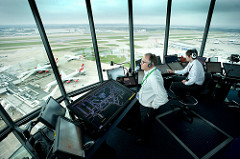 Air traffic management is a system for making sure that all aircraft are safe at all times. In the same way that drivers of cars have to obey the rules of the road, pilots also have a huge number of laws and regulations they must adhere to ensure the safety of the shared airspace, runways and airports.
Air traffic management is a system for making sure that all aircraft are safe at all times. In the same way that drivers of cars have to obey the rules of the road, pilots also have a huge number of laws and regulations they must adhere to ensure the safety of the shared airspace, runways and airports.
Air traffic managers communicate with pilots and other parties to keep everyone informed about weather, traffic advisories and other incidents. Air traffic control also works with the pilot through each phase of flight. Many of us only know take-off, cruise and landing. There are actually seven phases of flight, beginning with preflight phase when the pilot and controller ensure that the predetermined route is understood and that a runway is clear for takeoff. The other steps in order are: Take-off, departure, en route (cruising at altitude), descent, approach and landing.
- Head back to 2014 and find out why the cloud may have helped us locate missing flight MH370
- Return to aeroplane
Passenger windows
Aeroplane windows are made of plexiglass and have multiple panes to withstand high pressures. On the perfectly rounded cylinder of the plane’s body the stress flows smoothly through the material. The flow is interrupted by the introduction of a window. If that window is rectangular, the interruption in stress flow is more significant, and pressure builds up on the sharp corners - pressure that can eventually smash the glass and crack the plane body. By using a window which is oval, the stress levels are more evenly balanced out.
You may have noticed that the inner window pane of the three panes has a tiny hole in it and this is also an engineering design feature. The hole provides a mechanism for the change in pressure between the robust outer pane and the innermost pane which is designed to withstand all types of passenger contact.
- Try our free course on structural integrity and investigate the I-35W bridge collapse
- Return to aeroplane
Landing gear
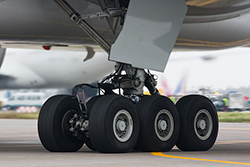 Aircraft landing gear is a critical sub-component and is designed to support the full weight of the airplane during ground operations and crucially during landing when kinetic forces are high. These forces need to be dissapated quickly so that they are not fully transmitted into the structural frame. Landing gear for most civil aircraft is fully retractable to reduce drag during the main flight, and it is attached directly to the main structural members of the aircraft.
Aircraft landing gear is a critical sub-component and is designed to support the full weight of the airplane during ground operations and crucially during landing when kinetic forces are high. These forces need to be dissapated quickly so that they are not fully transmitted into the structural frame. Landing gear for most civil aircraft is fully retractable to reduce drag during the main flight, and it is attached directly to the main structural members of the aircraft.Landing gear is usually specifically designed for the aeroplane model. Landing gear has to be able to provide good suspension under all conditions, as well as taking care of the braking of the wheels and the steering of the aircraft. Typically the gear will be used for a maximum of 60,000 landings, after this it deemed unsafe for reuse - this is to ensure the safety of passengers. The need to reduce weight, volume, life-cycle cost and development time of the gear system whilst still being able to provide strength, stability, stiffness, control, damping and ground clearance creates many trade-offs for engineering. Average construction time is 6-8 months per unit due to the high level of machining and precision engineering required.
- Try our free course 'Engineering: The nature of problems'
- Return to aeroplane
Aircraft tyres
Aircraft tyres are composed of three main components – rubber, nylon cord and steel. These three are combined through the process of vulcanisation in which bonding between the three occurs.
Tyres come in two main types called radial and cross-ply (commonly known as bias). Bias tyres have a series of casing plies running diagonally at approximate right angles to one another. Casing plies are layers of fabric cord coated with hi-modulus rubber on both sides. You could imagine these as being threads or meshes and by placing these meshes in different directions you can control the tyre strength and load capacity.
Some bias aircraft tyres feature inter-tread reinforcing fabric which provides additional high-speed stability, reduces tread distortion under load, protects the casing plies from damage and can act as wear indicators on retreadable tyres. Bias tyres are more popular than radials.
Radial tyres uses plies that all run radially from bead to bead at approximately 90° to the centre-line of the tyre. Radial tyres can offer low weight but tend to be less retreadable than a bias ply tyre. Retreading the tyre when carried out properly can be significantly cheaper than repurchase and has some environmental benefits.
Aircraft Cabin Temperature
The air pressure, temperature and quality inside the aircraft needs to be manipulated for human survival. At high altitude the pressure is much lower than at ground level.
Very cold air, typically -20 C at altitude, ‘bleeds’ into the aircraft air control system via the engines and is then filtered and heated to the appropriate temperature for use in the cabin. The air exchange rate is quite high, with a total volume of cabin air exchanged every 2-3 minutes, requiring a system which is constantly switched on. The engines drive the system using excess heat and the general idea is to maintain a constant cabin temperature, around 21 C, with fewer draughts and reduced odours.
The aircraft body is lined with insulation but this is only a few centimetres thick, another reason for needing continuous heating or cooling. The silver tubes cool down very quickly and heat up very quickly (if you have ever landed at Las Vegas and got stuck on a runway you will know what that feels like!).
The insulation also ensures that passengers don’t come into contact with any cold metal structures and helps to reduce external noise from the wind and engines. You may sometimes have noted that your luggage is quite cold and this because some of the luggage holds are not as highly insulated as the main cabin area, with thickness varying from 1-5 inches depending on whether it is the floor, roof or sides of the body.
- Learn more about temperature in engineering with our free course 'Engineering: The challenge of temperature'
- Return to aeroplane
Composites
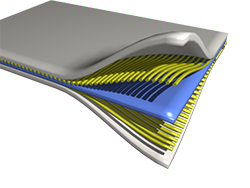
Composite materials, or composites, are materials that have been made from two or more other materials that were significantly different from one another, and when they are combined they create a material that has characteristics different from the individual components. The final product is usually much superior to the single materials. If you imagine fibreglass surfboards from the 1950’s period you wouldn’t be too far wrong.
The layers within a composite do not dissolve into a single one thing but rather act in unison to create an advanced composite material. These are normally made of a fibrous material embedded in a resin matrix, generally laminated with fibers oriented in alternating directions which gives the resulting material a strength and stiffness which is better than simply 1-2 layers.
Composites have been used in aviation for a very long time, especially for the spoilers, fairings (outer body coverings where streamlined shapes are needed), and parts where weight gain is preferred over aluminium.
The latest generation of large civilian aircraft is built up with all composite fuselages (the main body part of a plane), wing structures, flaps and other major components. Composite materials have high strength, relatively low weight with high corrosion resistance.
Wind turbine blades are also made of composite materials so that they are light yet strong as well. In aviation these composites have technical names such as carbon fibre reinforced plastic (CFRP) or glass fibre reinforced plastic. Sandwiches of CFRP are also used in many modern aircraft. Many of these materials are simply called laminates as they are indeed laminated together as each layer in built up and then cured with heat to precisely secure it into place.
- Try our free course 'Introducing engineering'
- Return to aeroplane
Winglets
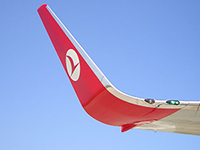 Winglets, also know as sharklets for some aircraft, are the vertical ‘fins’ at the end of the main wingtips and they provide important functions for the aircraft. At the edge of the wing there can be wing tip vortices – that is regions of unstable ‘air’. The use of the vertical stabiliser on the wingtip reduces the drag around the wingtip area and these can be optimised for different speeds.
Winglets, also know as sharklets for some aircraft, are the vertical ‘fins’ at the end of the main wingtips and they provide important functions for the aircraft. At the edge of the wing there can be wing tip vortices – that is regions of unstable ‘air’. The use of the vertical stabiliser on the wingtip reduces the drag around the wingtip area and these can be optimised for different speeds.
The winglets are usually made of composites or aluminium and on some aircraft they have been retrofitted in order to increase overall fuel efficiency. Blended winglets are those which have smooth curves whereas traditional winglets made be at a right angle.
In either case the winglets might be quite long – some are about 1.8 metres high and are visible during flying and manevouring. Others are even taller being about 2.4 m in height. On some aircraft the winglet extends both upwards and downwards creating a triagular shape at the end of the wingtip know as a wingtip fence.
You may have also noticed on the top of some wings tiny ‘fins’ or triangles arranged in a linear patterns – these are called vortex generators. These small attachments are designed to promote positive laminar airflow – in other words smooth, continuous flow, over the wing and control surfaces. The vortices created by these small looking devices swirl downward assisting maintenance of the boundary layer of air flowing over the wing. The boundary layer when maintained helps reduce friction and aids overall efficiency.
- Try our free course 'Design'
- Return to aeroplane
Emissions and trip footprint
 There is no such thing as an “average trip length” for all aviation passengers, but if we consider an typical flight from the UK to Europe one can derive typical emissions for such a trip. For example, let’s assume that your flight is from somewhere in the south of England to the south of Spain, one way – in this case we’ll use Stansted Airport to Malaga, Spain. The flight calculators show that this is a flight distance of some 1730 kilometres and it assigns 155 kilograms of cabon dioxide to each passenger. Approximately 6124 kg of fuel is burned during that flight and the calculator displays what types of aircraft typically fly on this route.
There is no such thing as an “average trip length” for all aviation passengers, but if we consider an typical flight from the UK to Europe one can derive typical emissions for such a trip. For example, let’s assume that your flight is from somewhere in the south of England to the south of Spain, one way – in this case we’ll use Stansted Airport to Malaga, Spain. The flight calculators show that this is a flight distance of some 1730 kilometres and it assigns 155 kilograms of cabon dioxide to each passenger. Approximately 6124 kg of fuel is burned during that flight and the calculator displays what types of aircraft typically fly on this route.
So, given these values one can calculate average emissions-per-distance for a whole variety of routes. One thing to consider is that when changing the calculator from short to medium and then long haul flights, there will be significant differences due to the aircraft type, seats occupied, and fuel consumed during the different phases of the flight. So extending the Spain example, the emissions are about 90 g/km, whereas if one models London-New York the overall emissions are 361 kg for 5536 km. It shouldn’t be a surprise that it is further away and takes more fuel (48,400 kg) to get there – creating more emissions. But in emissions-per-distance it results in 65 g/km due to better overall efficiency, probably for en-route phase, and the increased passenger load for the given aircraft considered. And don’t forget you need to add your return flights, rental cars, hotel and food to you total emissions summary!
- Try our free course 'Transport and sustainability'
- Return to aeroplane
Building an aircraft
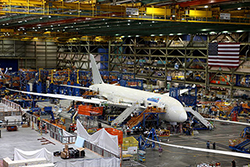 Building an aircraft is a complex task which requires hundreds, if not thousands, of suppliers and a large, highly skilled workforce to bring it all together. For the 737 aircraft, the company uses large scale systems integration to bring all of the parts and sub-assemblies together at the right time and in the right place. The production line recently moved to a Toyota-styled lean production system which means that the plane bodies glide slowly along moving about two inches every minute with an army of people climbing into the empty shells slowing converting them to airworthy flying machines.
Building an aircraft is a complex task which requires hundreds, if not thousands, of suppliers and a large, highly skilled workforce to bring it all together. For the 737 aircraft, the company uses large scale systems integration to bring all of the parts and sub-assemblies together at the right time and in the right place. The production line recently moved to a Toyota-styled lean production system which means that the plane bodies glide slowly along moving about two inches every minute with an army of people climbing into the empty shells slowing converting them to airworthy flying machines.
Each aircraft needs 367,000 parts. Just under 10,000 employees work in that factory with an average output of about 31 aircraft per month meaning that it takes about 11 days to produce one 737. Their main competitor is Airbus with their A320. As time goes on the factory system will devise more advanced ways of reducing the overall production time making large savings for every incremental improvement. All of these improvements comes down to a competitive advantage in which both Boeing, and Airbus, are trying to strive to be in the number one producer position for single aisle aircraft of this size. This battle is set to continue for some time with the recently released Dreamliner (787) to compete directly against the Airbus A350 series.
Lost luggage
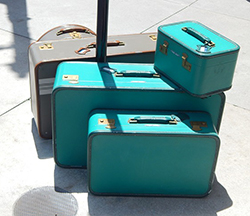 When was the last time you lost your luggage? Hopefully not recently, and if it was there is a good possibility that it was returned to you relatively quickly. Lost bags, or more appropriately, mishandled luggage, accounted for some 24 million units in 2014. Given that there were nearly 3.3 billion passengers in the same period this equates to some 7.3 bags per 1000 passengers which seems quite low. This has dropped from a peak of approximately 22 bags per 1000 passengers back in 2006 so clearly things are moving in the right direction.
When was the last time you lost your luggage? Hopefully not recently, and if it was there is a good possibility that it was returned to you relatively quickly. Lost bags, or more appropriately, mishandled luggage, accounted for some 24 million units in 2014. Given that there were nearly 3.3 billion passengers in the same period this equates to some 7.3 bags per 1000 passengers which seems quite low. This has dropped from a peak of approximately 22 bags per 1000 passengers back in 2006 so clearly things are moving in the right direction.
SITA, the manufacturers of the World Tracer System for baggage, found that just over 80% of the misplaced bags were reunited within 36 hours of being reported. Just under half of the luggage going missing seems to be transfer-related (i.e. when passengers have to make connecting flights), and then the next biggest category is when luggage fails to load or ticketing errors, accounting for 15% each. Tagging errors, loading errors, and failure to arrive all make up the remainder of issues with each only being a few percent. Of all the bags that are reported missing just over 5% are never found, and are reported as either lost or stolen. Airlines tend to stop tracking luggage after about 100 days as this is linked to the system and also the clearing houses which then auction off any remaining unclaimed items.
Make your own aerodynamic glider:
Paper aeroplanes follow exactly the same principles as full size gliders. As they move through the air they create drag (back along their flight path) and lift (at right angles to their flight path). In steady flight, these two aerodynamic forces exactly balance gravity. For the best performance, the designer and builder of gliders have to get minimum drag for maximum lift. This gives the flattest possible flight path which in turn means the furthest flight.
In this video we illustrate this theory and Andrea gives instructions for making a basic "Dart" glider:
To further explore this theory and build other models at home why not check out our Suzanne, Boomerang, Bomber and F14 videos out on YouTube.
Explore more engineering...
-
Introducing engineering
Learn more to access more details of Introducing engineeringEngineering encompasses a broad range of disciplines from design to manufacturing. This free course, Introducing engineering, introduces a number of key themes that explore how engineering is undertaken in our modern world. These themes include engineering design, rules that govern engineers, manufacturing for products and electricity ...

-
Engineering: The nature of problems
Learn more to access more details of Engineering: The nature of problemsEngineering is about extending the horizons of society by solving technical problems, ranging from the meeting of basic human needs for food and shelter to the generation of wealth by trade. In this free course, Engineering: The nature of problems, we learn that engineers see the problems more as challenges and opportunities than as difficulties...

-
Engineering: The challenge of temperature
Learn more to access more details of Engineering: The challenge of temperatureEngineering is about extending the horizons of society by solving technical problems, ranging from the meeting of basic human needs for food and shelter to the generation of wealth by trade. This free course, Engineering: The challenge of temperature, looks at the impact of changes in temperature on a variety of objects and looks at the problem ...

Explore more design...
-
Design thinking
Learn more to access more details of Design thinkingAre you ever frustrated with something that you thought you could design better? This free course, Design thinking, will show you how to structure your natural creativity to come up with solutions to all kinds of problems, and have fun in the process too!

Free course
10 hours
Level: 1 Introductory
-
People-centred designing
Learn more to access more details of People-centred designingDesigned products surround us all and range from bus tickets to buildings. This free course, People-centred designing, focuses firmly on usability and the increasingly important phenomenon of people-centred design. It aims to inform consumers of design (i.e., all of us) about this crucial characteristic of design. In addition to stimulating ...

Free course
12 hours
Level: 1 Introductory
-
Design
Learn more to access more details of DesignThis free course looks at the process of design, from assessing the complexity of design as an activity to exposing the difficulty in making general conclusions about how designers work. You will be able to identify innovation in a wide variety of designed objects and evaluate the impact of this innovation.

Free course
28 hours
Level: 1 Introductory
Acknowledgements and References
Acknowledgements
Thank you to Fiona Durham (Open Library Services) for research support.
References
- https://www.youtube.com/watch?v=XQ-9MoEMg7E
- https://www.infosys.com/engineering-services/white-papers/Documents/landing-gear-design-and-development.pdf
- https://www.youtube.com/watch?v=B7ArUqpgeHk
- http://www.dunlopaircrafttyres.com/tech_support/aircraft-tyre-technology.aspx
- http://superbeefy.com/how-do-airliners-keep-cabin-temperatures-warm-and-comfy-when-the-aircraft-is-flying-in-cold-air/
- https://www.youtube.com/watch?v=SJZk9vNS8NE
- http://www.icao.int/environmental-protection/CarbonOffset/Pages/default.aspx
- http://www.nbcnews.com/id/36507420/ns/business-us_business/t/hundreds-suppliers-one-boeing-airplane/%20-%20.VxSzNtgVGpo
- http://www.dailymail.co.uk/home/moslive/article-1308128/Boeings-billion-dollar-gamble-Inside-worlds-biggest-building-new-787-Dreamliner-plane-built.html
- http://www.telegraph.co.uk/travel/travel-truths/What-happens-to-lost-luggage/
Rate and Review
Rate this activity
Review this activity
Log into OpenLearn to leave reviews and join in the conversation.
Activity reviews